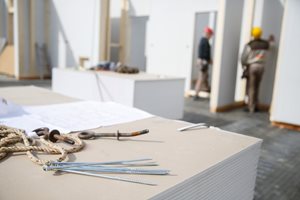(1/4/2021)
The $400 billion healthcare construction industry has seen many changes over the years. As healthcare construction has evolved, new materials and technologies have been introduced, and building standards, which are set by the Facility Guidelines Institute and reviewed by The Joint Commission, have been updated. Many trends have come and gone, but there’s one trend that is continuing to expand and set to advance the industry – prefabrication and modular construction.

Modular construction is the process of building a project off-site using modules, then fitting them together in a pre-planned order at the job site. Modular construction is accomplished under controlled plant conditions, with the same materials and following the same standards as conventionally built facilities.
The Modular Building Institute explains that “buildings are produced in ‘modules’ that when put together on site, reflect the identical design intent and specifications of the most sophisticated site-built facility – without compromise.”
Modular construction often allows teams to complete projects in half the time, but as with any new process, benefits and challenges must be considered.
The most significant benefit of modular construction is that it increases the “speed to market,” allowing teams to cut down on the time needed to complete a facility. For the healthcare industry especially, this is an important factor as it means patients can be admitted into healthcare facilities at a faster rate. Both modular and regular construction involve creating a detailed design plan and receiving permit approvals, but with modular construction, teams are able to prevent delays from the groundbreaking process or inclement weather since the project is built off-site. Some conventional construction projects could take 12 months to complete, where they could’ve been finished in just 60-90 days through modular construction.
Modular construction is also a more cost-efficient option. Expensive delays can be avoided, and the quality control is unmatched with specialized inspections as the modules are constructed. As modular construction continues to grow in popularity, the cost to manufacturers will also decrease costs even more.
The process of modular construction is streamlined to offer a reliable format and timeline. Once you’ve built one healthcare facility using modular construction, it’s easy to repeat this process to create a cohesive branding standard familiar to your associates and patients.
While modular construction presents many benefits, there are also disadvantages to construction off-site. The modules need to be carefully rigged and transported to the job site, which can create many challenges. Mistakes during transit can cause expensive repairs to the modules. Since the turnaround time is quick, the process also requires higher initial costs. It’s crucial to connect with your manufacturer to get a big picture of anticipated costs, timing and decisions.
Embracing this trend relies heavily on the capabilities of your manufacturing partner. If your manufacturer does not have the capacity to produce your vision or the maturity in their distribution channel, conventional construction may be a better option, or it may be time to find a new manufacturing partner.
Construction builds the foundation of all facilities and making the right decision for your project is a necessity. Healthcare buildings operate 24 hours a day and provide a safe healing environment for patients, making it imperative to stay up-to-date on the latest trends.
Want to learn more about Medxcel and our services? Contact us at
info@medxcel.com or 855-633-9235.